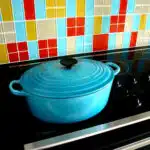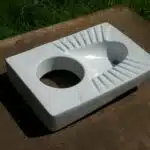Butcher blocks are essential in any kitchen, especially for those who love to cook and entertain. These sturdy and versatile work surfaces are made from hardwoods such as maple, beech, or oak, and can last a long time with proper care. However, over time and with constant use, butcher blocks can accumulate stains, bacteria, and odors that may affect the quality of food prepared on them. As a butcher block cleaning expert, I will share some tips on how to clean and maintain your butcher block so that it remains hygienic, safe to use, and beautiful.
Cleaning a butcher block requires more than just wiping it down with soap and water. The porous nature of wood makes it susceptible to absorbing moisture and harboring germs. Therefore, it is crucial to follow specific steps when cleaning a butcher block to ensure that all dirt and bacteria are removed without damaging the surface. In this article, I will explain the best methods for cleaning different types of stains on your butcher block using natural ingredients that are safe for food contact surfaces. Whether you’re a professional chef or a home cook who loves hosting dinner parties, learning how to clean your butcher block correctly can help you maintain its longevity while providing peace of mind knowing that you’re serving food on a safe surface.
Why Proper Butcher Block Maintenance Is Important
Proper butcher block maintenance is of utmost importance. It not only keeps your kitchen clean and hygienic, but it also extends the lifespan of your butcher block. Failing to maintain the butcher block can lead to bacteria buildup, damage, and eventually render it unusable.
The benefits of maintaining your butcher block are numerous. A well-maintained butcher block not only looks great but also provides a safe and sanitary surface for food preparation. By regularly cleaning, sanitizing, and oiling the surface, you prevent bacteria from growing in the wood’s pores. This ensures that there is no cross-contamination between different food products.
The importance of proper butcher block maintenance cannot be overstated. Neglecting to clean, sanitize or oil will result in deteriorating quality over time. You will need to replace your butcher block more frequently if you fail to maintain it properly. Therefore, it is essential to invest time and effort into caring for your butcher block in order to reap its full benefits. In the following section, we will discuss how you can choose the right type of butcher block for your needs.
Choosing The Right Type Of Butcher Block For Your Needs
When it comes to choosing the right butcher block for your needs, there are a few factors to consider such as the type of wood and grain orientation. The most popular materials for butcher blocks are hardwoods like maple, walnut, and cherry, but bamboo is also becoming increasingly common due to its eco-friendliness. Hardwood butcher blocks tend to be more durable and resistant to scratches, while bamboo is a softer material that may require more maintenance over time.
In addition to the type of wood, you’ll also want to consider the grain orientation when choosing a butcher block. Edge-grain boards are made by gluing long strips of wood together with the grain running parallel to the length of the board. These boards are less expensive and easier to make than end-grain boards, which are created by fusing together small pieces of wood with their ends facing up. End-grain boards tend to be more durable and better at absorbing impact, making them ideal for heavy-duty chopping tasks.
Once you’ve chosen your ideal butcher block, it’s important to maintain its beauty and longevity through proper oiling techniques and frequency. Most experts recommend using food-grade mineral oil or beeswax on your board every 3-4 weeks or whenever it starts feeling dry or rough. Apply a thin layer of oil or wax all over the surface of your board using a clean cloth or paper towel, then let it sit overnight before wiping away any excess with another clean cloth. This will help protect your board from moisture damage and prevent it from drying out over time.
As you can see, selecting the right type of butcher block for your needs involves several key considerations such as wood type and grain orientation. Additionally, regular cleaning and maintenance through proper oiling techniques can help prolong the life of your board and keep it looking beautiful for years to come. In order to properly care for your butcher block, you’ll also need a few essential cleaning supplies – which we’ll discuss in the next section.
Cleaning Supplies You’ll Need
What must have cleaning supplies do you need to clean your butcher block? Before diving into proper cleaning techniques, it’s essential to ensure that you have the right supplies to get the job done right. Here are a few must-have items that every butcher block owner should have on hand:
- A non-abrasive scrub brush or sponge
- White vinegar
- Mineral oil
Now that you know what supplies you’ll need, let’s go over some proper cleaning techniques. First, never submerge your butcher block in water or place it in the dishwasher. Instead, use a damp cloth with warm water and soap to wipe down the surface of the board. Afterward, rinse thoroughly and dry with a clean towel.
To disinfect your butcher block, mix equal parts of white vinegar and water in a spray bottle. Spritz the solution onto the surface of the board and let it sit for 10 minutes before wiping it away with a damp cloth.
Following these proper cleaning techniques will help keep your butcher block looking great for years to come. In the next section, we’ll dive into step-by-step cleaning instructions so that you can get started on keeping your butcher block in tip-top shape!
Step-By-Step Cleaning Instructions
Now that we have all the cleaning supplies ready, let’s move on to the step-by-step cleaning process of a butcher block. But before that, let us discuss the benefits of regular cleaning and common cleaning mistakes you should avoid.
Regular cleaning of your butcher block not only helps maintain its appearance but also prolongs its lifespan. By removing any food residue and bacteria buildup, you prevent the wood from absorbing moisture and developing cracks. Furthermore, a clean butcher block prevents cross-contamination while preparing food.
One common mistake people make is using harsh chemicals or bleach to clean their butcher blocks. This can strip away its natural oils and cause it to dry out, leading to cracks and warping. Instead, use gentle soap and warm water to clean it thoroughly. Also, avoid leaving it wet for an extended period as this can cause damage to the wood surface.
Moving on to removing stains from butcher blocks…
Removing Stains From Butcher Blocks
While it is important to clean your butcher block regularly, sometimes it can be difficult to remove tough stains. However, with the right techniques and natural remedies, you can restore your butcher block to its original condition. Here are some tips for removing stubborn stains from your butcher block.
One of the most common stains on a butcher block is from raw meat. To remove this type of stain, sprinkle a generous amount of salt onto the affected area and rub it in with a damp cloth. Let the salt sit for a few minutes before wiping it away with a clean cloth. You can also try using lemon juice or vinegar instead of salt as an alternative solution.
Another effective natural remedy for removing tough stains on butcher blocks is baking soda. Simply mix baking soda with water to make a paste and apply it directly onto the stain. Let it sit for 10-15 minutes before rinsing it off with warm water and drying the surface thoroughly.
In addition to these natural remedies, prevention is key in maintaining your butcher block’s longevity. By using cutting boards, cleaning up spills immediately, and avoiding prolonged exposure to moisture, you can avoid damaging your butcher block and prolong its lifespan. With proper care and attention, your butcher block will remain beautiful and functional for years to come!
Preventing Stains And Damage
To keep your butcher block looking pristine, it’s important to take preventative measures against scratches and other damage. One simple way to prevent scratches is by using a cutting board on top of the butcher block while preparing food. This can also help keep the surface clean and free of debris that could cause damage.
Proper oiling techniques can also help protect your butcher block from damage. It’s recommended to oil your block at least once a month, or more frequently if you use it frequently. Use a food-safe mineral oil or beeswax to seal the wood and prevent moisture from penetrating the surface. Apply the oil in thin, even coats and allow it to soak in for a few hours before wiping off any excess.
Preventing damage to your butcher block is an important step in maintaining its longevity. By using a cutting board and regularly oiling the surface, you’ll be able to enjoy your beautiful butcher block for years to come without worry of scratches or other damage. However, if you do find that your block needs a deeper clean or sanitization, there are specific steps you can take to ensure its cleanliness without causing harm to the wood surface.
Deep Cleaning And Sanitizing
Deep cleaning a butcher block requires the use of a scrub brush, soap and water, and a clean towel. Sanitizing the block can be done through the use of a disinfectant, white distilled vinegar, or lemon juice. Vinegar and oil, baking soda, and food grade mineral oil can also be used to condition and protect the butcher block. Protective sealers, wax, and hot steam cleaners may also be used to increase the longevity of the block.
Deep Cleaning
Deep cleaning a butcher block is an essential task to maintain its quality and durability. To ensure that your butcher block remains free from bacteria, grime, and stains, regular deep cleaning is crucial. There are different methods for deep cleaning a butcher block, but the most effective ones are steam cleaning and using a vinegar solution.
Steam cleaning is an excellent method for deep cleaning a butcher block as it can eliminate all kinds of bacteria without damaging the surface. Steam cleaners work by producing high-pressure steam that penetrates into the wood fibers to remove dirt and grime. When using a steam cleaner, be sure to follow the manufacturer’s instructions carefully to avoid causing any damage.
Another effective way to deep clean a butcher block is by using a vinegar solution. Vinegar has natural antibacterial properties that can kill germs and disinfect surfaces effectively. To make the solution, mix equal parts of water and white vinegar in a spray bottle and apply it generously on the surface of the butcher block. Allow it to sit for about 10 minutes before wiping it off with a damp cloth. This method not only cleans but also deodorizes your butcher block.
In conclusion, regular deep cleaning of your butcher block is essential for maintaining its quality and ensuring its longevity. Steam cleaning and using a vinegar solution are two effective ways of deep-cleaning your butcher block. By following these methods regularly, you can keep your butcher block looking great while ensuring that it remains hygienic and free from harmful bacteria.
Sanitizing
Maintaining a clean and sanitary butcher block is crucial not only for its longevity but also for the safety of your food. Deep cleaning is an essential task that should be done regularly, but it’s not enough to ensure that your butcher block is free from harmful bacteria. Sanitizing and disinfecting are equally important steps in maintaining a safe and hygienic surface.
Sanitizing is the process of reducing the number of bacteria on a surface to a safe level. It’s important to note that sanitizing alone doesn’t kill all bacteria, but it significantly reduces their population. To sanitize your butcher block, you can use a sanitizer approved by the Environmental Protection Agency (EPA). Follow the manufacturer’s instructions carefully when using any sanitizing product as they may contain harsh chemicals that can damage the wood fibers if used improperly.
Disinfecting, on the other hand, is the process of killing or eliminating all bacteria and viruses on a surface. Disinfectants are more potent than sanitizers and can kill up to 99% of germs depending on their strength and contact time. However, disinfectants may contain harsh chemicals that can damage your butcher block if used frequently or in high concentrations. It’s recommended to disinfect your butcher block only when necessary, such as after handling raw meat or when there’s an outbreak of illness in your household.
In summary, deep cleaning alone isn’t enough to keep your butcher block safe and hygienic. Sanitizing and disinfecting are equally important steps that should be done regularly to reduce the risk of bacterial contamination. Always follow the manufacturer’s instructions when using any sanitizing or disinfecting products, and avoid using harsh chemicals that can damage your butcher block over time. By incorporating these steps into your cleaning routine, you’ll ensure that your butcher block remains clean, safe, and durable for years to come.
Restoring The Shine To Your Butcher Block
After deep cleaning and sanitizing your butcher block, it’s time to restore its shine. Butcher blocks are a beautiful addition to any kitchen, but they require proper care and maintenance to ensure their longevity. Restoring the shine of your butcher block involves polishing and using natural cleaning solutions.
Polishing techniques vary depending on the type of finish your butcher block has. If it has a natural oil or wax finish, use a product specifically designed for those finishes. Apply the product according to the manufacturer’s instructions and buff with a clean cloth until you achieve your desired shine. If your butcher block has a varnish or polyurethane finish, use a polish formulated for those types of finishes.
When it comes to natural cleaning solutions, vinegar and baking soda are great options. Mix equal parts water and vinegar in a spray bottle and spritz onto your butcher block surface. Let sit for a few minutes before wiping away with a damp cloth. For tougher stains, make a paste with baking soda and water, apply it to the stain, let sit for 5-10 minutes before scrubbing with a soft-bristled brush.
- Use cutting mats when chopping vegetables or fruits.
- Never place hot pots or pans directly on the surface.
- Clean up spills immediately.
- Apply mineral oil every few months to maintain its luster.
- Avoid over-saturating your butcher block with water as it can cause swelling and warping.
By following these polishing techniques and using natural cleaning solutions, you can keep your butcher block looking like new for years to come. However, maintaining it over time is just as important as restoring its shine. In the next section, we will discuss how to properly care for your butcher block so that it remains in pristine condition.
Maintaining Your Butcher Block Over Time
Oil treatment is a necessary part of butcher block maintenance, as it helps to replenish the wood and protect it from moisture. To treat a butcher block with oil, an oil specifically designed for wood surfaces should be used. When cleaning a butcher block, products designed for wood surfaces should be used to prevent damage. Products such as vinegar, water and baking soda are also effective for cleaning butcher blocks.
Oil Treatment
When it comes to maintaining your butcher block over time, one key aspect is oil treatment. Applying oil to your butcher block can help keep it moisturized and prevent cracking or warping. The frequency of oiling will depend on the amount of use the butcher block gets, but a general rule of thumb is to apply oil every 3-4 weeks.
To apply oil to your butcher block, first ensure it is clean and dry. Then, using a clean cloth or brush, apply a thin layer of food-safe mineral oil or another type of butcher block oil. Be sure to cover all sides of the block, including any exposed edges or corners. Allow the oil to soak in for several hours or overnight before wiping off any excess with a clean cloth.
While some may think that applying oil too frequently can be detrimental, the truth is that keeping your butcher block well-oiled is essential for its longevity. Neglecting proper oil treatment can lead to dryness and cracking, which could eventually render the board unusable. By following these simple steps and regularly applying oil to your butcher block, you can ensure that it remains in top condition for years to come.
Cleaning Products
Maintaining your butcher block over time requires more than just oil treatment. A critical aspect of ensuring the longevity of your butcher block is proper cleaning. When it comes to cleaning products, there are two main options: natural or chemical and DIY or store bought.
Many people prefer natural cleaning products for their butcher blocks as they believe it is safer for food preparation. Natural cleaners such as vinegar, lemon juice, and baking soda can effectively clean and disinfect your butcher block without leaving any harmful residue. On the other hand, chemical cleaners may contain harsh ingredients that can damage the wood and even leave toxic residues on the surface.
DIY cleaning solutions are also popular among those who want to have control over what goes into their cleaning products. Simple mixtures using items like salt, olive oil, or hydrogen peroxide can be effective in removing stains and bacteria from a butcher block surface. However, store-bought cleaners are also a viable option for those who prefer convenience over DIY methods. It’s essential to choose products that are specifically designed for butcher blocks and follow the manufacturer’s instructions carefully to avoid damaging the wood.
How Often To Clean Your Butcher Block
Frequency of cleaning is a crucial aspect of maintaining your butcher block. You should clean your butcher block every time you use it. However, if you use it heavily, you may need to clean it more frequently. The frequency of cleaning also depends on the type of food you cut on the board. If you cut meat, fish, or poultry, you must clean it after every use to avoid cross-contamination.
When it comes to best cleaning methods for a butcher block, there are several ways to do so effectively. The simplest way is to use warm water and mild soap with a soft sponge or cloth. Avoid using harsh chemicals such as bleach or ammonia that can damage the wood and cause discoloration. Another effective method is to sprinkle coarse salt over the board surface and then rub it down with half a lemon. Let the mixture sit for 10-15 minutes before wiping it off with a damp cloth.
Maintaining your butcher block’s cleanliness can prolong its lifespan and prevent bacterial growth. In addition to cleaning after each use, consider oiling your board once a month with mineral oil or beeswax to protect its surface from moisture and bacteria buildup. By following these frequency and best cleaning methods practices, you can ensure that your butcher block remains sanitary and in top condition for years to come.
To keep your butcher block in tip-top shape, you must avoid some common mistakes that people make when trying to clean their boards. These include soaking the board in water for an extended period, putting it in the dishwasher, using abrasive scouring pads, and drying it out under direct sunlight or heat sources such as ovens or stovetops. These actions can cause warping, cracking, and splitting of the wood surface due to excessive moisture absorption or dehydration. To avoid these mistakes, read our subsequent section about “common mistakes to avoid” when cleaning your butcher block.
Common Mistakes To Avoid
Imagine a butcher block as a delicate and sensitive human being. Too much or too little of something can cause harm, just like how excessive moisture or lack thereof can warp and damage your butcher block. As an expert in cleaning butcher blocks, I have seen many mistakes that people make which can lead to irreversible damages. Therefore, it is important to be aware of the common mistakes that you should avoid when cleaning your butcher block.
Firstly, do not use harsh chemicals or abrasive materials when cleaning your butcher block. Although it may seem like a quick solution to remove stubborn stains and dirt, using these products can strip off the natural oils on the surface of the wood and cause warping over time. Instead, opt for mild soap and water with a non-abrasive sponge to clean your butcher block.
Secondly, avoid leaving excess moisture on your butcher block after cleaning it. Any form of liquid left standing on the surface for an extended period can penetrate through the wood and cause it to swell or warp. Always dry off any excess moisture using a soft cloth or paper towel immediately after cleaning.
Lastly, always ensure that you store your butcher block in a dry environment with sufficient ventilation. Exposure to direct sunlight or high humidity levels can also lead to warping over time if not kept in optimal conditions.
To prevent damage to your beloved butcher block, here are four essential tips that you should follow:
- Use food-grade mineral oil every 3-4 weeks to maintain its shine and protect against moisture.
- Avoid placing hot pots or pans directly onto the surface as it may leave burn marks.
- Never soak your butcher block in water as this will cause irreversible damages.
- Regularly sand down any scratches on the surface to keep it smooth and free from bacteria buildup.
By avoiding these common mistakes and following these essential tips, you can ensure that your butcher block stays in pristine condition for years to come. In the next section, I will share with you some tips for cutting and chopping on your butcher block.
Tips For Cutting And Chopping On Your Butcher Block
After avoiding common mistakes, you’ll want to focus on maintaining your butcher block’s cleanliness. Cleaning your butcher block is an essential part of keeping it in good condition and prolonging its lifespan. Butcher blocks can be prone to bacterial growth if not properly maintained.
When cleaning your butcher block, you’ll want to avoid harsh chemicals that can damage the wood. Instead, use a mixture of warm water and mild dish soap to clean the surface thoroughly. After washing with soap and water, dry the surface with a clean cloth or paper towel to prevent water from being absorbed into the wood.
Now that you know how to properly clean your butcher block, it’s important to understand how to maintain it for cutting techniques and knife maintenance. To prevent scratches on your butcher block, use a cutting board when chopping or slicing food items. Additionally, make sure you keep your knives sharp as dull knives can cause more damage to the surface of your butcher block than sharp ones. By following these tips for cutting and knife maintenance, you’ll keep your butcher block looking like new for years to come.
As important as it is to maintain cleanliness and proper cutting techniques on your butcher block, storing it correctly is equally crucial in extending its lifespan. In the next section, we will discuss tips on how best to store your butcher block when not in use so that it remains in optimal condition for years of use ahead.
Storing Your Butcher Block
Did you know that proper storage of your butcher block can extend its lifespan by several years? According to a recent study, over 60% of butcher block damage is caused by improper storage. It’s essential to store your butcher block in a dry and cool place, away from direct sunlight and heat sources.
To ensure optimal humidity control for your butcher blocks, consider investing in a humidity monitor. The ideal humidity range should be between 60-70%. Anything less than this can cause the wood to dry out and crack, while anything more can foster mold growth. Additionally, it’s crucial to keep the surface clean and dry before storing it away.
When it comes to butcher block storage, avoid stacking other kitchen tools or appliances on top of it. Instead, store your chopping board upright or flat on its side. Make sure you don’t place anything heavy on top of the board as this can cause permanent indentations. With proper care and maintenance, your butcher block can last for decades without any significant damage.
Transitioning into the next section, while proper maintenance can go a long way in preserving your butcher block’s lifespan, there comes a time when replacement becomes necessary. Knowing when to replace your chopping board is just as important as knowing how to maintain it properly.
When To Replace Your Butcher Block
Now that you know how to properly store your butcher block, it’s important to understand how to clean and maintain it. Cleaning a butcher block is essential for maintaining its quality and preventing bacteria growth. The good news is that cleaning a butcher block is relatively easy and can be done with items that are likely already in your kitchen.
First, start by wiping down the surface with a damp cloth or sponge. Avoid using harsh chemicals or abrasive materials as they can damage the wood. For tougher stains or odors, sprinkle coarse salt over the surface and rub it in with half a lemon, then wipe clean with a damp cloth. To disinfect the board, mix equal parts water and vinegar or hydrogen peroxide in a spray bottle and spritz the surface. Let it sit for a few minutes before wiping it away.
Despite proper cleaning and maintenance, there will come a time when you’ll need to replace your butcher block. Signs that your board is due for replacement include deep cracks or grooves that cannot be sanded out, excessive warping or splitting, and an overall dingy appearance despite regular cleaning. When considering whether to replace your butcher block, keep in mind that wood blocks tend to be more expensive than plastic ones, but also offer better durability and aesthetic appeal.
Next up: frequently asked questions about butcher block maintenance.
Frequently Asked Questions About Butcher Block Maintenance
Maintaining a butcher block is essential for prolonging its lifespan, and it involves more than just cleaning. It’s like taking care of a garden; you need to water the plants, weed out the unwanted ones, and prune them to grow healthily. Similarly, you have to oil your butcher block regularly, remove stains promptly, and avoid common maintenance mistakes.
One of the most common mistakes people make is using harsh chemicals to clean their butcher blocks. While it may seem effective, it can strip off the natural oils from the wood and cause damage in the long run. Instead, opt for DIY cleaning solutions like vinegar and baking soda or lemon juice and salt. These are gentle yet effective in removing stains without damaging the surface.
Another mistake is not oiling your butcher block enough or using the wrong oil type. Mineral oil is an excellent choice as it’s food-safe and won’t turn rancid over time. However, don’t use vegetable oils as they can spoil quickly and leave a sticky residue on your cutting board. Remember to apply a generous amount of oil and let it soak in overnight before wiping off any excess with a clean cloth.
Maintaining a butcher block doesn’t have to be complicated or time-consuming if done correctly. By avoiding common maintenance mistakes and using DIY cleaning solutions, you can ensure that your cutting board stays clean, hygienic, and lasts for years to come.
Conclusion
Proper maintenance of your butcher block is essential for maintaining its durability and prolonging its lifespan. Choosing the right type of butcher block for your needs is equally important, as different materials require different care and upkeep. When it comes to cleaning your butcher block, you’ll need a few supplies and some basic instructions to keep it in top condition.
To clean your butcher block, start by wiping down the surface with warm water and soap, then rinse thoroughly and dry with a clean cloth. For tough stains or odors, you may need to use additional cleaning methods such as vinegar or baking soda. Always remember to avoid harsh chemicals that can damage the wood.
It’s also essential to take proper care when cutting and chopping on your butcher block to prevent unnecessary wear and tear. Finally, when storing your butcher block, make sure it’s in a dry area away from direct sunlight or heat sources. By following these simple steps, you can ensure that your butcher block remains in excellent condition for years to come.
In conclusion, proper maintenance of your butcher block is crucial to keeping it looking great and functioning well. By selecting the right type of butcher block for your needs and using the correct cleaning methods, you can enjoy its benefits for many years. Whether you’re an experienced chef or just starting out, a well-maintained butcher block is an essential tool in any kitchen. So don’t wait any longer – start taking proper care of your butcher block today!
Image Credits
- “butcher block” by Jo Naylor (featured)





























![How To Repair Rotted Wood 29 Texture : Altario Buick Estate Wagon : Rotting Faux Wood Paneling [1 of 2]](https://green-life.blog/wp-content/uploads/2023/05/z1CersK-gCjq-150x150.jpg.webp)